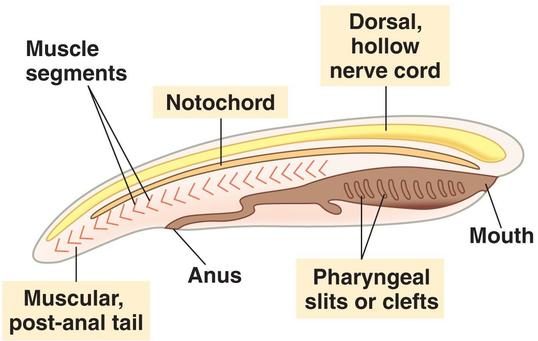Topic Content:
- Characteristics of Phylum Chordata
- Classification of Phylum Chordata
- Subphylum Vertebrata
- Classes of Vertebrates
- Class Pisces (Fishes)
- Class Amphibia (Amphibians)
- Class Reptilia (Reptiles)
- Class Aves (Birds)
- Class Mammalia

Characteristics of Phylum Chordata:
1. All chordates including the vertebrates have a flexible rod-like structure, the notochord (a simple pre-backbone structure), at some stage of their development.
2. They have a tubular dorsal nerve chord. This a bundle of nerves running along the “back” that splits into the brain and the spinal cord. It is hollow and lies dorsal to the notochord.
3. They have pharyngeal gill slits at some stage of their life histories. They are openings that allow the entry of water through the mouth without entering the digestive system. In many aquatic forms, they are lined with vascular lamellae, which form gills for respiration.
4. Post-anal tail: It is an extension of the body that runs past the anal opening.
5. The body has an organ system level of organisation.
6. They are true coelomates.
7. Bilaterally symmetrical, triploblastic, coelomic, and segmented body.
8. A well-differentiated and complex body.
Note: The notochord is the defining structure of the chordates, and has essential roles in vertebrate development. In vertebrates a backbone or vertebral column replaces the notochord, therefore all vertebrates are chordates, but all chordates are not vertebrates.
Classification of Phylum Chordata:
Phylum Chordata is classified into three subphyla, namely;
1. Urochordata (tunicates)
2. Cephalochordata (lancelets)
3. Vertebrata (vertebrates)
Subphylum Vertebrata:
All vertebrates have these features:
1. They are bilaterally symmetrical.
2. An internal skeleton or endoskeleton of bone and cartilage with a backbone or vertebral column made up of a series of small bones called vertebrae.
3. A well-developed central nervous system with a brain (within a brain case).
4. They have well-developed sense organs.
5. A closed blood circulatory system made up of a muscular heart.
6. The heart is three or four-chambered.
7. They have two pairs of limbs. The pair attached to the thoracic region is modified to form arms or wings, while the pelvic appendages have developed to form the pelvic fins, hind limbs, or legs.
8. They have kidneys for eliminating body waste.
9. The skin of vertebrates may be naked or have a covering of scales, feathers, or hairs.
10. They are triploblastic.
Classes of Vertebrates:
We have five major classes of vertebrates
a. Class: Pisces
b. Class: Amphibia
c. Class: Reptilia
d. Class: Aves
e. Class: Mammalia
a. Class Pisces (Fishes):
You are viewing an excerpt of this Topic. Subscribe Now to get Full Access to ALL this Subject's Topics and Quizzes for this Term!
Click on the button "Subscribe Now" below for Full Access!
Subscribe Now
Note: If you have Already Subscribed and you are seeing this message, it means you are logged out. Please Log In using the Login Button Below to Carry on Studying!



Responses